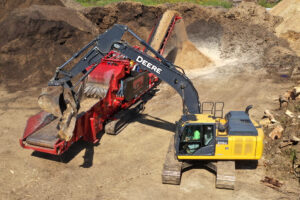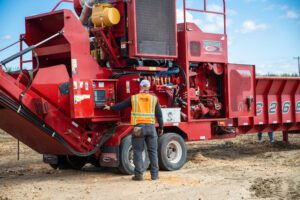Don’t Throw Away Your Profits: our US manufacturing partner Rotochopper provides a detailed explanation of grinding basics and how a grinder can turn waste into profits.
Grinding wood waste is a tough job, but Rotochopper makes it look easy. And knowing what type of machine you need, doing the right maintenance and following proper guidelines can help you improve your grinding operation. Rotochopper sits down with FOCUS enviro to share its best insights, whether you are about ready to buy a new machine or have been grinding for years, this guidance can make your operation better.
Tips for Buying a New High Speed Grinder in Australia
FEED MATERIAL

So let’s say you are looking to turn wood waste and scraps into a profitable fiber product. A grinder will help you turn a waste stream into a revenue stream. You need to start with both the beginning and end in mind. These questions should guide your thinking. What type and size of material are you trying to process? Is it hardwood or softwood? Species? Scrap material from recycling pallets, such as dismantling pallets to reclaim usable lumber? Whole scrap or waste pallet?
DESIRED VOLUME
The volume can also impact the selection criteria because some units have a higher capacity than others. And will this volume change or grow in the future? How much could this change?
END PRODUCT
The desired end product is a critical consideration. Will grindings be supplied to various outlets for further processing or as a finished, value-added product? Are you making mulch, animal bedding, biomass, pellets, or fiber for producing an engineered wood product? How clean does the material need to be and what type of contaminants could it have?
If a company needs to grind used scrap lumber or scrap pallets from pallet recycling operations, the separation of nails and nail fragments likely will be an important consideration. It is always important to talk with potential customers for the end product and find out what their requirements are. You never want to assume that you know what they need. For example, if a company wants to turn material into particleboard, it will need to go through a hammermill. What are the requirements of that machine?
MOBILITY

How important is mobility? Will you be grinding in one spot or moving it around? An electric unit can work well for stationary grinding. Some electric grinders are also available in portable configurations with electric quick connects to allow operation at multiple locations. But a diesel-powered unit might be more effective if you are frequently switching between multiple grinding sites. Do you have the availability of adequate 3-phase power if you are planning on using an electric model? Power considerations can play a major role in proper grinder selection.
CONTAMINATION
FOCUS enviro offer both grinders and shredders. There are some important differences to consider between grinders and shredders. Grinders will run at a higher rotor RPM than a shredder. A shredder uses torque to rip, snap and shear the wood apart. A grinder uses velocity to refine the particles until they are the right size to pass through the screen openings. Shredders, while running at lower speeds, can handle waste with a high percentage of contaminants much better than grinders but can offer lower production rates and reduced particle size control.
FEEDING METHOD
When companies begin processing waste for the first time, one of the things that is most frequently overlooked is how they are going to feed the machine. You want a process that will keep up with the flow of material and the capacity of the grinder. Also, you want to reduce the labour required as much as possible. What is going to be the most efficient, cost-effective way to collect or divert residual material to the grinder? A conveyor belt? Collecting material into hoppers and using a forklift to dump the contents into the grinder in batches?

A horizontal grinder offers flexibility for feeding, but feeding methods and equipment can make a big impact on efficiency. A horizontal grinder can be batch fed with a forklift, wheel loader, and other common types of handling equipment. One of the most efficient methods is to integrate the grinder in-line with a conveyor that handles the wood waste. Feeding the grinder shouldn’t be an afterthought—it should be an integral part of your planning process.
IDENTIFYING MARKET REQUIREMENTS
Another key as you get started is the end product you are going to produce. Identifying profitable fiber market opportunities is a critical part of the decision on what grinder best fits your needs. You have to construct the right business model and place the right grinder in that model.
You have to start by asking, where is the waste going now? Someone is profiting and someone is paying. Is it going to a landfill or is someone recycling the wood fiber into mulch, animal bedding, or another product?
Finding the right market is the guiding issue behind the entire process. You identify profitable markets and make sure the grinder fits that business model. Some grinders can make biomass but not animal bedding. Some grinders can make colored mulch; others require another processing step such as the EDGE ColourPRO dye trommel. You need to understand the market before getting a grinder to fit that market.
STRONG PERFORMANCE AND MAINTENANCE
Everyone knows that better maintenance leads to improved production. But sometimes it can be easy to ignore the little details. When it comes to top maintenance concerns, you have to do basic housekeeping and monitor wear items. General housekeeping is always considered a best practice. 
For best tooth and hammer maintenance, you need to keep the surfaces in proper condition. Tooth maintenance is crucial. It affects overall production along with end product sizing. Checking tooth condition should be part of routine pre-start procedures.
You want to pay attention to the little details, such as fine tuning the feed settings to maximize efficiency. Once settings are dialed in, maintain consistent operating procedures to maximize efficiency. When grinding full pallets, feed the material evenly and avoid stacking pallets too high, so that raw material enters the mill evenly.
Don’t hesitate to turn to your local Austrlian distributor; FOCUS enviro for expertise. Customer service is not just about fixing a machine that has a problem or ordering replacement parts. Good customer service is about providing the right guidance so you know how to optimize the performance of your grinder.
What differentiates Rotochopper from the other OEMs?

Rotochopper top selling features include particle size control, uptime and the simplicity of maintenance. Particle size is critical in maximizing your profits. Being able to produce quality consistent particle sizing, for the lowest cost will help turn your wood waste into a profit center.
Uptime is important because your business continually generates a waste product. So ease of grinder maintenance is critical. No other grinder can match the simplicity of changing screens, accessing the rotor than Rotochopper.
Rotochopper also has a number of unique patents and proprietary technology that help it stand out. This includes: a gap-less infeed transition system, quick screen change system, a patented StopWatch grinder monitoring system, and an electric motor start assist (patent pending).
If you haven’t considered adding a grinder, stop to think about what you are doing with your wood waste. Are there local markets to turn this into an actual profit center?
DISCOVER YOUR SOLUTION TODAY
One of the best ways to discover the perfect solution is to call FOCUS enviro today for a free consultation. See more about the entire Rotochopper line via focusenviro.com.au.
FOCUS ENVIRO – The Home of Waste Shredders
At FOCUS enviro we offer tailored solutions, from single equipment supply to complete integrated processing systems. We effectively service the waste and organics industries by offering selected technologies that are proven, innovative, relevant, and reliable.
We only work with world class experienced manufacturers and suppliers that specialise in the waste and organics industries, that understand the challenges of processing material in these sectors and who can offer custom solutions that are as individual as each customer and application.


